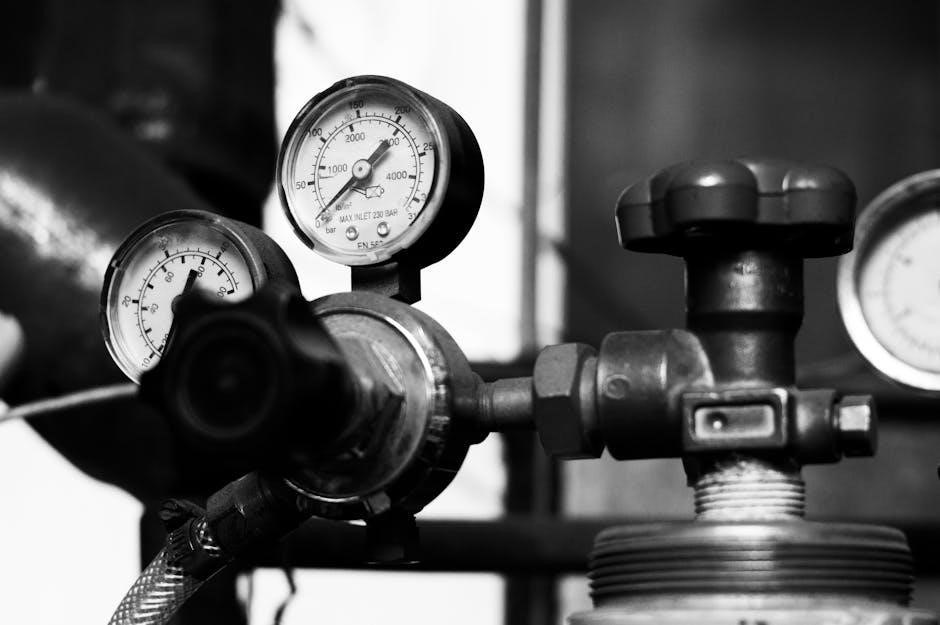th400 reverse manual valve body
The TH400 is a robust three-speed automatic transmission known for its strength and reliability, making it a popular choice for high-performance and racing applications. Its reverse manual valve body enhances control, particularly in racing scenarios, offering precise shifting and improved driver command. This transmission’s durability and versatility have solidified its reputation as a favorite among enthusiasts and professionals alike.
Overview of the TH400 Transmission
The TH400 is a three-speed automatic transmission renowned for its strength and reliability, making it a favorite for high-performance and racing applications. Built with a robust design, it features a reverse manual valve body that enhances driver control, especially in racing scenarios. Its popularity stems from its durability and adaptability, allowing it to handle heavy-duty use while maintaining smooth shifting capabilities. The TH400’s versatility has made it a staple in both street and track environments, solidifying its reputation as a reliable workhorse for enthusiasts and professionals alike.
History and Popularity of the TH400
The TH400 transmission was introduced in the 1960s by General Motors, quickly gaining a reputation for its strength and durability. Its popularity soared due to its ability to handle high torque and its versatility across various vehicle types. The reverse manual valve body further enhanced its appeal, particularly in racing and high-performance applications, where precise control and rapid shifting are critical. Over the years, the TH400 has remained a favorite among enthusiasts and racers, solidifying its legacy as a reliable and powerful transmission.
Understanding the Reverse Manual Valve Body
The reverse manual valve body is a modified component designed for manual gear engagement, enhancing driver control and precision in high-performance and racing applications.
What is a Reverse Manual Valve Body?
A reverse manual valve body is a specialized component designed for the TH400 transmission, enabling manual gear engagement. It replaces the automatic shift mechanism with a manual system, requiring a shifter and transbrake for operation. This setup is popular in drag racing, allowing drivers to hold the transmission in reverse or first gear before launching; The RMVB enhances control and precision, making it ideal for high-performance applications where quick, accurate shifts are critical.
Benefits of a Reverse Manual Valve Body
Installing a reverse manual valve body in a TH400 transmission offers enhanced control and precision, particularly in racing scenarios. It eliminates the reliance on automatic shifting, allowing drivers to manually engage gears for faster and more precise shifts. This setup is ideal for drag racing, as it enables the use of a transbrake, which holds the car stationary before launch. The RMVB also reduces wear on internal components by minimizing automatic shifting during high-stress situations, improving overall durability and performance.

Key Features and Benefits
The TH400 with a reverse manual valve body offers manual shifting, precision control, and enhanced performance, making it ideal for racing applications while maintaining durability and reliability.
Improved Performance and Control
The TH400 with a reverse manual valve body delivers enhanced performance by eliminating delays in gear engagement, allowing for precise, driver-controlled shifts. This setup reduces lag and provides immediate response, especially in high-stress racing conditions. The manual control enables drivers to better manage power delivery, optimizing acceleration and maintaining traction. Additionally, the ability to manually command shifts ensures consistent performance, making it ideal for competitive environments where every fraction of a second counts. This level of control and responsiveness is a significant upgrade over stock configurations.
Enhanced Driver Command and Precision
The reverse manual valve body in the TH400 grants drivers unparalleled command over gear shifts, allowing for precise, instantaneous control. This setup eliminates reliance on hydraulic pressure, enabling direct mechanical actuation of gears. Drivers can execute shifts with surgical precision, particularly in high-stress racing environments, where exact control is critical. The manual operation reduces ambiguity in gear engagement, ensuring smooth transitions and consistent performance. This level of driver involvement and accuracy is a significant advancement over traditional stock configurations, making it a preferred choice for competitive applications.

Installation and Setup
Installing a TH400 reverse manual valve body requires careful preparation and attention to detail. Begin by draining the transmission fluid and removing the pan to access the valve body. Disconnect linkages and electrical connectors, ensuring they are labeled for reconnection. Remove the old valve body, then install the new one, securing it with bolts tightened evenly to prevent warping. Reconnect all components, refill with the correct fluid, and replace the pan. Test the system for leaks and proper function to ensure a successful setup.
Step-by-Step Installation Guide
Drain the Transmission Fluid: Start by safely draining the transmission fluid into a pan to prevent spills and mess.
Remove the Pan: Take out the transmission pan bolts and carefully lower the pan to access the valve body.
Disconnect Linkages: Detach the shift linkages and electrical connectors, labeling them for easy reconnection.
Remove the Old Valve Body: Gently pull out the existing valve body, taking care not to damage surrounding components.
Install the New Valve Body: Align and insert the reverse manual valve body, ensuring it seats properly.
Reconnect Components: Reattach all linkages and connectors, double-checking for secure connections.
Refill Fluid: Pour in the recommended transmission fluid, avoiding overfilling.
Replace the Pan: Reinstall the pan and tighten bolts evenly to prevent leaks.
Test the System: Start the engine, cycle through gears, and check for leaks or unusual behavior.
Common Mistakes to Avoid
- Incorrect Alignment: Misaligning the valve body during installation can lead to improper gear engagement and potential damage.
- Insufficient Fluid Replacement: Failing to replace the transmission fluid and filter can cause debris buildup and premature wear.
- Overlooking Vacuum Modulator Leaks: Not addressing leaks can result in erratic shifting and reduced performance.
- Improper Torque Specs: Using incorrect torque on bolts can lead to leaks or component failure.
- Skipping System Testing: Not testing the transmission after installation can mask issues like no forward gears or rough shifts.
Troubleshooting Common Issues
Common issues include no forward gears, rough shifts, and fluid-related problems. These often stem from faulty direct clutches, worn band servos, or dirty fluid. Addressing these promptly ensures optimal performance and prevents further damage to the transmission.
Diagnosing No Forward Gears
No forward gears in a TH400 transmission can be caused by issues like a faulty vacuum modulator or problems with the direct clutch pack. Check for fluid contamination or debris in the pan, as dirty fluid can clog the filter and restrict pressure. Inspect the direct clutch for wear or discolored discs, and ensure the band servo is functioning properly. Addressing these issues promptly prevents further damage and restores gear engagement.
Addressing Rough Shifts
Rough shifts in a TH400 transmission can often be traced to issues like a malfunctioning vacuum modulator or dirty fluid. Ensure the valve body is clean and free of debris, as contamination can disrupt pressure regulation. Check the direct clutch pack and servo band for wear, as these components are critical for smooth gear transitions. Replacing the transmission fluid and filter can also resolve rough shifts by eliminating contaminants and ensuring proper lubrication and pressure flow.
Maintenance and Upkeep
Regular fluid and filter changes are essential for maintaining the TH400’s performance. Checking for leaks and ensuring proper vacuum modulator function prevents operational issues, while clean fluid ensures smooth gear engagement and longevity of internal components.
Regular Maintenance Tips
Regular maintenance is crucial for the TH400 transmission with a reverse manual valve body. Always check the transmission fluid level and condition, ensuring it’s clean and at the recommended level. Replace the fluid and filter every 30,000 to 60,000 miles to prevent debris buildup. Inspect the pan gasket for leaks and tighten the bolts if necessary. Clean or replace the transmission cooler lines to maintain proper cooling. Additionally, ensure the vacuum modulator is functioning correctly, as any leaks can affect performance. Regularly inspect the valve body for wear and tear, and replace any damaged components promptly to avoid transmission failure. By following these tips, you can extend the life of your TH400 and maintain its optimal performance.
Fluid and Filter Replacement
Fluid and filter replacement is essential for maintaining the TH400 transmission’s performance. Use high-quality ATF (Automatic Transmission Fluid), such as ATF+4, to ensure optimal lubrication and cooling. Replace the fluid every 30,000 to 60,000 miles, depending on usage. Always install a new filter during fluid changes to prevent contamination. Inspect the pan for debris and clean it thoroughly before refilling. Dirty fluid can clog the filter and damage the transmission. Regular fluid changes help maintain smooth shifting and prevent premature wear on internal components.

Comparison with Stock Valve Body
The reverse manual valve body offers enhanced control and precision compared to the stock valve body, making it ideal for racing and high-performance applications. While more complex and costly, it provides superior shifting accuracy and reliability in demanding conditions.
Performance Comparison
The reverse manual valve body outperforms the stock valve body with enhanced control and precision, especially in high-stress situations like racing. It offers more direct and predictable shifts, reducing slippage and improving overall transmission reliability. While it adds complexity and cost, the performance gains make it a worthwhile upgrade for enthusiasts seeking optimal drivetrain responsiveness. The stock valve body, though reliable, lacks the precision and control of its manual counterpart, making the reverse manual valve body the preferred choice for demanding applications.
Cost and Complexity Considerations
Upgrading to a reverse manual valve body increases both cost and complexity compared to the stock setup. The manual valve body is more expensive due to its specialized design and precision engineering. Installation requires advanced mechanical skills and tools, adding to the overall expense. Maintenance is also more involved, as manual adjustments and inspections are necessary. However, for high-performance applications, the enhanced control and durability justify the additional investment and effort, making it a worthwhile upgrade for serious enthusiasts and racers.

Racing and High-Performance Applications
The TH400 with a reverse manual valve body excels in racing and high-stress environments, offering enhanced control and precision. Its robust design ensures reliability under intense conditions.
Optimizing for Drag Racing
The TH400 with a reverse manual valve body is a top choice for drag racing due to its enhanced control and precision. It allows for faster, more consistent shifts, which is critical in high-stress racing environments. The valve body’s design enables better command over gear engagement, reducing slippage and improving torque delivery. Additionally, the transmission’s durability ensures it can withstand the intense demands of drag racing, making it a reliable option for competitors seeking optimal performance and reliability.
Enhancing Control in High-Stress Situations
The TH400 with a reverse manual valve body excels in high-stress environments by providing precise control over gear shifts. This setup eliminates reliance on the vacuum modulator, allowing for more consistent and predictable engagement. The mechanical operation ensures rapid and firm shifts, reducing slippage and heat buildup. This level of control is crucial in racing and heavy-duty applications, where split-second precision and reliability are paramount. The reverse manual valve body enhances driver confidence and performance under intense conditions, making it a preferred choice for demanding scenarios.
The TH400 transmission with a reverse manual valve body offers unmatched strength, reliability, and control, making it a top choice for racing and high-performance applications. Its precise shifting capabilities and enhanced driver command ensure optimal performance in demanding scenarios, solidifying its reputation as a superior transmission option for enthusiasts and professionals alike;
The TH400 transmission with a reverse manual valve body offers exceptional strength, reliability, and precision control, making it ideal for high-performance and racing applications. It delivers enhanced driver command, reducing wear on components and improving overall performance. The reverse manual valve body provides precise shifting, crucial for high-stress situations, and is favored by enthusiasts for its durability and versatility in demanding driving conditions.
Final Thoughts and Recommendations
The TH400 transmission with a reverse manual valve body is a highly reliable and versatile choice for both racing and street applications. Its strength and precision make it ideal for high-performance needs. For optimal results, proper installation and maintenance are crucial. Enthusiasts seeking enhanced control and durability should consider this setup, especially for demanding driving conditions. Always consult professionals for complex modifications and ensure regular upkeep to maximize performance and longevity.
